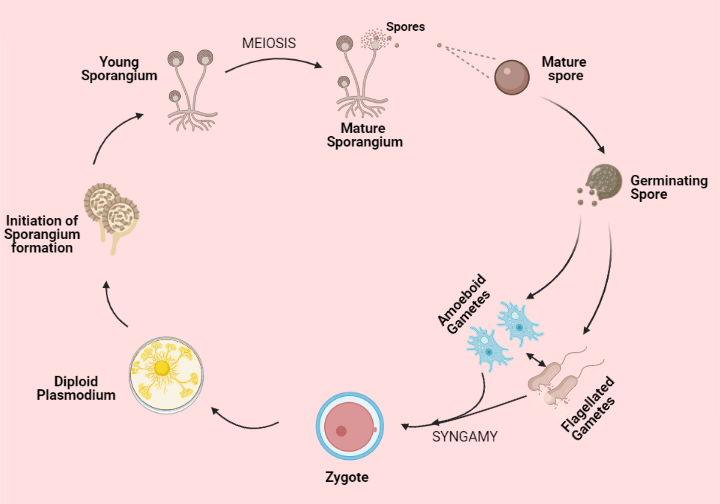
Give an account of somatic structure and life cycle of an acellular slime mould that you have studied.
Answer
428.4k+ views
Hint: Slime moulds are of two types: cellular and acellular. In their life cycles, acellular slime moulds have a "plasmodium" period. Plasmodium consists of millions of nuclei that share a single, gigantic cell to differentiate them without any membranes.
Complete answer:
1) Plasmodium is the name of the somatic structure of the acellular slime mould. It is inherently diploid. It consists of a protoplasm multinucleate. In the protoplasm, it has many diploid nuclei which continue to divide by mitosis. It has no definite form at all. With the help of finger-like projection, the movement is called pseudopodia. It also includes moving strands for locomotion, called phaneroplasmodium.
2) In nature, it is saprophytic. It relies for growth and nourishment on dead and rotting matter. For food, it also consumes bacteria, protozoa, etc.
3) Prior to entering the reproductive process, plasmodium exceeds a certain size. The slime dries during this process. The diploid protoplasm concentrates, creating a cushion-like mass at a few stages. This structure-like mould grows into a stalked sporangium.
4) The diploid protoplas divides into several young spores each having a diploid nucleus.
5) To form a meiospore, the diploid nucleus of the spore undergoes meiosis.
6)The Meiospore is released and dispersed by wind after maturation. It falls on a substratum.
7) Then it germinates to release swarm cells under the favorable state of moisture, temperature and pH. These act in pairs like gametes and fuse to form the zygote.

Note: 1) Acellular slime mould can reach 1ft. In diameter.
2) They reproduce asexually in absence of food and moisture.
3) Examples include Physarum, Cribaria, etc.
Complete answer:
1) Plasmodium is the name of the somatic structure of the acellular slime mould. It is inherently diploid. It consists of a protoplasm multinucleate. In the protoplasm, it has many diploid nuclei which continue to divide by mitosis. It has no definite form at all. With the help of finger-like projection, the movement is called pseudopodia. It also includes moving strands for locomotion, called phaneroplasmodium.
2) In nature, it is saprophytic. It relies for growth and nourishment on dead and rotting matter. For food, it also consumes bacteria, protozoa, etc.
3) Prior to entering the reproductive process, plasmodium exceeds a certain size. The slime dries during this process. The diploid protoplasm concentrates, creating a cushion-like mass at a few stages. This structure-like mould grows into a stalked sporangium.
4) The diploid protoplas divides into several young spores each having a diploid nucleus.
5) To form a meiospore, the diploid nucleus of the spore undergoes meiosis.
6)The Meiospore is released and dispersed by wind after maturation. It falls on a substratum.
7) Then it germinates to release swarm cells under the favorable state of moisture, temperature and pH. These act in pairs like gametes and fuse to form the zygote.

Note: 1) Acellular slime mould can reach 1ft. In diameter.
2) They reproduce asexually in absence of food and moisture.
3) Examples include Physarum, Cribaria, etc.
Recently Updated Pages
Master Class 11 Accountancy: Engaging Questions & Answers for Success

Glucose when reduced with HI and red Phosphorus gives class 11 chemistry CBSE

The highest possible oxidation states of Uranium and class 11 chemistry CBSE

Find the value of x if the mode of the following data class 11 maths CBSE

Which of the following can be used in the Friedel Crafts class 11 chemistry CBSE

A sphere of mass 40 kg is attracted by a second sphere class 11 physics CBSE

Trending doubts
10 examples of friction in our daily life

One Metric ton is equal to kg A 10000 B 1000 C 100 class 11 physics CBSE

Difference Between Prokaryotic Cells and Eukaryotic Cells

State and prove Bernoullis theorem class 11 physics CBSE

What organs are located on the left side of your body class 11 biology CBSE

The combining capacity of an element is known as i class 11 chemistry CBSE




